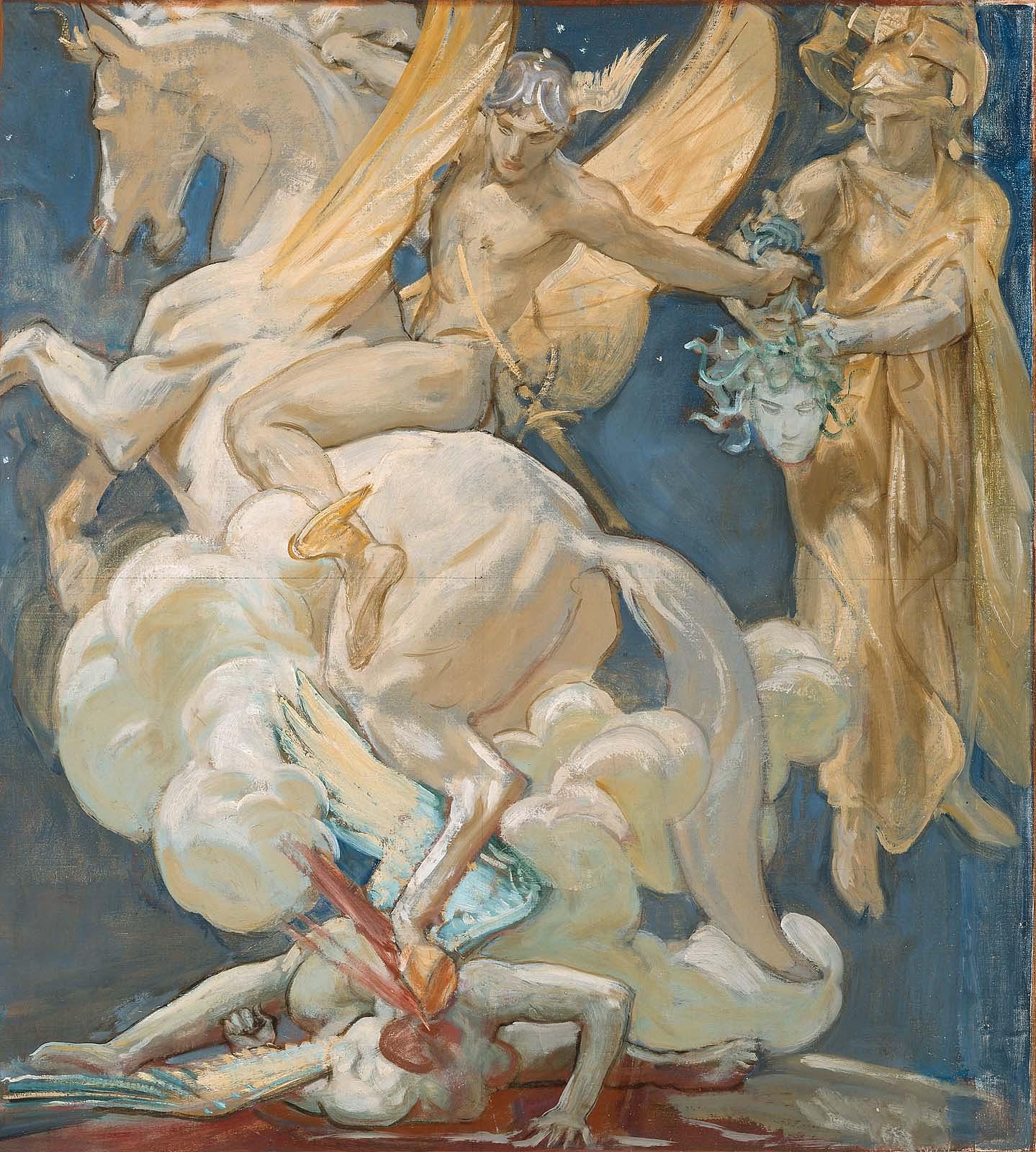It struck me after viewing the Gallery concerning Aphrodite’s birth, that many strange births occur in Greek mythology. Was it the idea of being able to envision the possibility of giving birth without following the usual and natural birth delivery, be it a goddess or a woman or even horses? Was it the need to add mysterious and supernatural elements to creation, to give eccentric accounts?
A famous goddess, Athena, was born out of Zeus’ head, as described by Hesiod:
…But by himself, from his head, he produced glancing-eyed Tritonis [Athena], 925 fierce, strife-stirring, army-leading, unsubdued, and awesome, to whom dins, and wars, and battle are a delight.
Theogony 924–926, Sourcebook[1]
Helen was born out of an egg. Leda, her mother was raped by Zeus who had turned himself into a swan. The chorus and Helen herself in Euripides’ Helen tell the myth.
You were fated, fated to have a life full of pain, when Zeus begot you on your mother, [215] shining through the air on the wings of a snow-white swan.
…
[255] Dear [philai] friends, to what a fate am I yoked? Did my mother bear me as a wonder to mankind? [For no other woman, Hellene or barbarian, gives birth to a white vessel of chicks, in which they say Leda bore me to Zeus.]Euripides Helen 212–218, 257–259, E. P. Coleridge, revised by Kosmos Society[2]
Bettany Hughes in her book Helen of Troy[3] notes that Helen’s unconventional birth has intrigued many artists (p.123). We will see some of their works in the Gallery, as well as art concerning Leda, Athena and others. Pausanias in his Description of Greece, 3.16.1, tells the story that when he travelled to Sparta he saw the well-preserved egg in which Helen was born; the egg was suspended with ribbons from the Spartan acropolis.[4]
In this gallery, you will see images of another strange birth that inspired artists: the birth of Pegasus, a winged beautiful horse that came out from the blood of Medusa as she was beheaded by Perseus. The last picture represents Athena with the Parthenon on her head, sculpted by Rodin. Is it a recall of Athena being born out of Zeus ‘head?
Images
Notes
[1] Hesiodic Theogony 1–115 Translated by Gregory Nagy, 116–1022 Translated by J. Banks and adapted by Gregory Nagy.
[2] Euripides, Helen Translated by E.P. Coleridge, revised by members of Kosmos Society
[3] Bettany Hughes. 2005. Helen of Troy: Goddess, Princess, Whore. New York.
[4] Pausanias Description of Greece, 3.16.1. Translation based on the original rendering by W. H. S. Jones, 1918 (Scroll 2 with H.A. Ormerod), containing some of the footnotes of Jones. Edited, with revisions, by Gregory Nagy
Image Credits
Birth of Athena from the head of Zeus, from a vase painting. Public domain via Wikimedia Commons
Birth of Athena. Attic exaleiptron (black-figured tripod), ca. 570–560 BCE. Found in Thebes. , Musée du Louvre
Photo: Bibi Saint-Pol. Public domain via Wikimedia Commons.
Birth of weaponed Athena who emerged from Zeus’ head. Musée du Louvre. Athena is “born” from Zeus’s forehead as a result of him having swallowed her mother Metis, as he grasps the clothing of Eileithyia on the right; black-figured amphora, 550–525 BCE, Louvre.
Photo: Bibi Saint-Pol Public Domain, Public domain via Wikimedia Commons
Leda and the Swan by Cesare da Sesto (c. 1506–1510, Wilton). Wilton House
Public domain via Wikimedia Commons
Leda and the Swan Painting after Leonardo da Vinci in Rome, probably by Cesare da Sesto, Galleria Borghese.
Public Domain via Wikimedia Commons
Leda and the Swan
https://www.metmuseum.org/art/collection/search/364519
Leda and the Swan, 16th-century copy after the lost painting by Michelangelo
Public Domain via Wikimedia Commons
Birth of Helen
Xinstalker, CC BY-SA 4.0, via Wikimedia Commons. Public domain via Wikimedia Commons
Giampietrino: Leda and her children c 1515–1520. Museumslandschaft Hessen Kassel.
Public domain via Wikimedia Commons
Cornelis Bos, after Michelangelo. c. 1530–1550. Leda and the Swan
Public domain via Wikimedia Commons
Thomas Rowlandson Leda and the Swan
Public domain via the Metropolitan Museum of Art
Mosaic: Leda and the swan (detail) Tile mosaic depicting Leda and the Swan from the Sanctuary of Aphrodite, Palea Paphos; now in the Cyprus Museum, Nicosia. 3rd century CE.
Photo: “Ken and Nyetta” Public domain via Wikimedia Commons
Huge votive red-figure kothon. The birth of Helen The representation shows Helen coming out of the egg, which is on an altar. Leda jumps back, startled, while Zeus, in the form of an eagle, watches from on high. Helen’s two brothers, the Dioskouroi Castor and Polydeukes, are present. Found in Analipsi (Vourvoura), Kynouria. last decade of the 5th c. BCE.
The National Archaeological Museum of Athens, Greece
Photo: Marsyas. Creative Commons Attribution-Share Alike 2.5 Generic license. via Wikimedia Commons
Attributed to the Diosphos Painter The Birth of Pegasus, Terracotta Lekythos (oil flask). c 500 BCE. “Perseus flying away with the head of Medusa, while Pegasos springs from her severed neck”
Public domain via the Metropolitan Museum of Art
Carle Vernet Pegasus 1820s, Printer François Séraphin Delpech
Museum of Fine Arts Boston Fair Use policy
John Singer Sargent (American, 1856–1925) Sketch for Perseus on Pegasus Slaying Medusa
By Public domain via Wikimedia Commons
Head of Athena with the Parthenon. Rodin Museum: Kosmos Media Library
Hélène Emeriaud is a Team member at HeroesX, a MOOC on edX. She studied ancient Greek at school in France and for several years at the University of Minnesota. She holds a degree in Education from Montreal University, and a Master of Education from McGill University. She is an active participant and member of the Editorial Team in the Kosmos Society with a particular interest in ancient Greek and Latin language learning.















